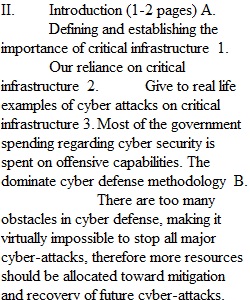


Q An outline is a plan for organizing your paper. While many short essays can be written without a formal plan, a research paper of this length and complexity requires it. You will have 2 options for completion: the Rogerian or the Classical Outline structure. Because you likely do not have all of your sources yet, this is a preliminary plan. In either outline, your main arguments must be clear. You must find at least 1 piece of literature to support each argument and identify 2 viewpoints opposed to your thesis. In each outline, the required information is highlighted in yellow. The rest of the outline will help you to stay focused and organized as you continue to add source information each week, but will not be due as an additional assignment. Regardless of which you choose, you must also submit at least 5 scholarly sources in APA format. This is the same citation style used in the Annotated Bibliography. Include the 4 from that assignment, and add at least one more that you've found since then. See this Example Reference Page (Links to an external site.). -------------------------------------------------------------------------------------------------------- • Option 1: The Rogerian Outline Download The Rogerian Outline This style of argumentation is covered in this week's Rhetoric Video. Arguments that aim to compromise are best suited to this style. For more information, see "What is a Rogerian Argument? (Links to an external site.)" Fill in the Rogerian Outline using the linked document. Paper by section Draft due I. Introduction Week 3 II. Summary of Opposing Viewpoints III. Statement of Understanding (Validation/Concession) Week 4 IV. Your Viewpoints and Support/Evidence V. Benefits of your Viewpoint Week 5 VI. Conclusion Week 6 To select this option, please download this document and type your responses directly into the outline. Review the rubric to check your responses. Then upload your completed Outline through this submission link. • Option 2: The Classical Outline Download The Classical Outline The Classical Outline uses Roman Numerals, numbers, and letters to help you organize your thoughts. Notes included in this document explain where to put your main ideas, examples, and analysis. While formulaic, it is also thorough, producing a well-organized, effective paper. Paper by section Draft due I. Introduction Week 3 II. Body 1 Arguments and Evidence Week 4 III. Body 2 Arguments and Opposing Viewpoints Week 5 VI. Conclusion Week 6 To select this option, please download this document and type your responses directly into the outline. Review the rubric to check your responses. Then upload your completed Outline through this submission link. A. Rubric Outline Rubric Outline Rubric Criteria Ratings Pts This criterion is linked to a Learning OutcomeReasons/Main Ideas 20 to >18.2 pts EXCELLENT - At least 3 relevant main ideas in complete sentences 18.2 to >16.4 pts GOOD - At least 3 relevant main ideas present; 2 in complete sentences 16.4 to >14.6 pts PROFICIENT - At least 3 relevant main ideas present, 1 in complete sentence. 14.6 to >12.8 pts DEVELOPING - 2-3 main topics present; none in complete sentences. 12.8 to >0 pts INCOMPLETE - main ideas not relevant, lacking substance, or not present 20 pts This criterion is linked to a Learning OutcomeEvidence - researched direct quotations or paraphrases 20 to >18.2 pts At least 3 relevant supporting pieces of evidence in complete sentences 18.2 to >16.4 pts At least 3 relevant pieces of evidence; 2 in complete sentences 16.4 to >14.6 pts At least 3 relevant pieces of evidence; 1 in complete sentence. 14.6 to >12.8 pts 3 pieces of evidence present; none in complete sentences OR less than 3 pieces of evidence given. 12.8 to >0 pts Evidence irrelevant, lacking substance, or not present 20 pts This criterion is linked to a Learning OutcomeExplanation 20 to >18.2 pts At least 3 explanations of evidence in complete sentences 18.2 to >16.4 pts At least 3 relevant explanations of evidence given; 2 in complete sentences 16.4 to >14.6 pts At least 3 relevant explanations of evidence given, 1 in complete sentence. 14.6 to >12.8 pts 3 explanations given; none in complete sentences OR less than 3 explanations given. 12.8 to >0 pts Explanantions irrelevant, lacking substance, or not present 20 pts This criterion is linked to a Learning OutcomeOpposing Viewpoints 20 to >18.2 pts At least 2 opposing Viewpoints in complete sentences with evidence OR explanation for both 18.2 to >16.4 pts 2 opposing viewpoints in complete sentences with evidence OR explanation for either. 16.4 to >14.6 pts 1 opposing viewpoint listed with evidence or explanantion OR 2 Opposing Viewpoints with no evidence or explanation 14.6 to >12.8 pts 1 Opposing Viewpoint with no evidence or explanation. 12.8 to >0 pts Opposing viewpoint irrelevant, lacking substance, or not present 20 pts This criterion is linked to a Learning OutcomeReferences 20 to >18.2 pts At least 5 academic reference entries included in APA format. 18.2 to >16.4 pts At least 5 academic reference entries included mostly in APA format--minor errors. 16.4 to >14.6 pts At least 5 academic reference entries included; some in correct APA format--noticeable errors. 14.6 to >12.8 pts At least 4 academic references given; frequent errors in APA format OR fewer than 4 sources are academic 12.8 to >0 pts Fewer than 4 sources given; References are mostly not academic; errors in APA format are substantial or not attempted. 20 pts Total Points: 100 PreviousNext
View Related Questions